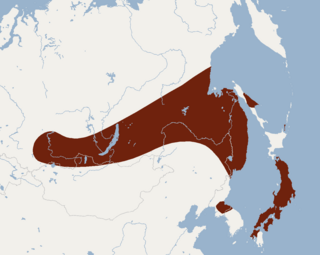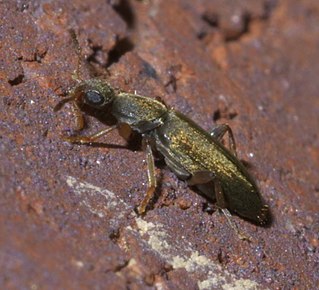
Servaea is a genus of jumping spiders that was first described by Eugène Louis Simon in 1888. S. murina females are about 8 millimetres (0.31 in) long.
Bullfinch is a name given to two groups of passerine birds.

Murina is a genus of vesper bats.

The flute-nosed bat is a vespertilionid bat with an unusually shaped nose, the tubular nostrils facing outward from the end of the muzzle. They occur in the north of the Australian state of Queensland, in Indonesia, and on Papua New Guinea.
Hutton's tube-nosed bat is a species of vesper bat in the family Vespertilionidae. It can be found in the following countries: China, India, Laos, Malaysia, Myanmar, Nepal, Pakistan, Thailand, and Viet Nam. It lives within an elevation of 1450 m to 2500 m. In Southeast Asia, the bat is considered to be uncommon. The bat is known to live in forests, roosting among the leaves of banana trees. Its habitat is threatened by deforestation for firewood and timber, as well as conversion to agricultural land.
The Taiwan tube-nosed bat is a species of vesper bat in the family Vespertilionidae. It is found only in Taiwan. It is a close relative of Hutton's tube-nosed bat, and might even be the same species.
The gloomy tube-nosed bat is a species of vesper bat in the family Vespertilionidae. It is only known by the holotype, an old female, collected on Tsushima Island in 1962. It might be possibly extinct as Tsushima is badly deforested and surveys to rediscover this species failed. Due to its imperiled status, it is identified by the Alliance for Zero Extinction as a species in danger of imminent extinction.
Scully's tube-Nosed bat is a species of vesper bat in the family Vespertilionidae. It can be found in the following countries: India, Laos, Myanmar, Pakistan, Thailand, and Viet Nam.

The Ussuri tube-nosed bat is a species of vesper bat in the family Vespertilionidae. It is threatened by habitat loss. It is the only species of bat that hibernates in snowbanks.

The mouse-colored tyrannulet is a species of bird in the tyrant flycatcher family Tyrannidae. It occurs in a wide range of scrubby and wooded habitats in tropical and subtropical South America, being absent from the southernmost part of the continent, the high Andes and dense rainforest. It also occurs in Panama and Costa Rica. It is generally common, but its small size and dull plumage results in it often being overlooked – or at least not identified, as it resembles several other tyrant flycatchers.

Harrison's tube-nosed bat is a species of vesper bats (Vespertilionidae). Within the genus Murina, it belongs to the so-called 'cyclotis-group'.

Hilgendorf's tube-nosed bat is a species of vesper bat in the family Vespertilionidae. In Japan they are called 'tengu komori', after the mythical creature called the Tengu. It was formerly thought to be a subspecies of Murina leucogaster, but is now known to be a distinct species.

Beelzebub's tube-nosed bat, also Beelzebub bat or demon bat, is a species in the vesper bat family Vespertilionidae, found in the Greater Mekong region of Southeast Asia, specifically the Quảng Trị and Gia Lai provinces of Vietnam. They have tube-shaped nostrils which assist them with their feeding.

Macratria is a genus of antlike flower beetles in the family Anthicidae. There are more than 30 described species in Macratria.

Macratriinae is a subfamily of antlike flower beetles in the family Anthicidae. There are at least 2 genera and more than 30 described species in Macratriinae.
Macratria confusa is a species of antlike flower beetle in the family Anthicidae. It is found in North America.
Macratria brunnea is a species of antlike flower beetle in the family Anthicidae. It is found in Central America and North America.
Cubaris murina, the little sea pillbug, is a species of woodlouse in the family Armadillidae. It is found in North America, Africa, South America, Australasia, Mexico, tropical Asia, and the Pacific Ocean.
Leptogaster murina is a species of robber flies in the family Asilidae.
Epicauta murina, the dark blister beetle, is a species of blister beetle in the family Meloidae. It is found in North America.









